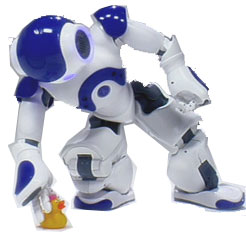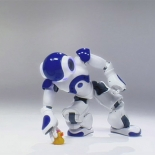How does the right force sensor improve robot design?

Robots in any industry, from consumer devices to manufacturing applications, must be able to sense whether or not a contact has been made, and/or how much force occurs during a given action.
Force Sensing is Vital to Proper Balance
Humanoid robots displaying proper balance while walking, running or dancing appear infinitely more life-like than those that don't. A robot with better balance means fewer falls. This translates to less damage to the robot itself, better handling of objects it might be carrying, and in general a more impressive display. Aldebaran Robotics has developed the most widely-used humanoid robot for academic purposes. Their Nao Robot is so fascinatingly life-like that it has been very successful in motivating students to learn the engineering and scientific principles behind robotic development. Aldebaran has embedded thin and flexible FlexiForce™ sensors into the feet of the robot to monitor balance. The sensors ensure that the robot properly shifts its weight so it does not tip over while walking or dancing.
The importance of the sensors and proper balance relates to the robots overall programming. Nao robots are programmed to walk in an omnidirectional walking pattern and have the ability to walk over different types of surface. When the weight of one part of the robot shifts, the center of mass of the machine must realign in order to attain proper balance. A well-balanced robot is not only aesthetically pleasing, but contributes to its overall function. A properly functioning robot is a valuable tool for researchers and students. The progressive nature of these machines provides insight into the future of robotics and the fields of engineering and mathematics.
Force Sensors Ensure Appropriate Grip Force
Automated manufacturing robots often feature grippers which might be handling very delicate material. For example, you may want to verify that your robot is using an appropriate grip force on semiconductor wafers during the manufacturing process. The thinness and customizability of FlexiForce sensors ensure that your force sensor will fit seamlessly into your design. This is also important in medical applications such as robotic surgery, where tactile feedback from a non-intrusive sensor can open doors to the use of procedures that are difficult to perform without a sense of touch. Grip is also important for the function of humanoid robots. For example, robots programmed to dispose of bombs must have the proper force behind their grip in order to avoid detonating an explosive device.
Benefits of FlexiForce™ Sensors
- Ultra-thin sensor construction and flexibility means minimal interference/disturbance to normal action
- Accurate response gives your customers and end users confidence in the performance of your product
- Knowledgeable, experienced technical staff help you develop the most effective, economical sensor based on your specific requirements. All manufacturing takes place at ISO 9001 compliant & 13485 registered Tekscan headquarters.
- 100% factory inspection ensures your sensors meet established performance specifications
Getting Started with FlexiForce Sensors
FlexiForce sensors are available off-the-shelf in packs of four or eight for testing and prototyping. Visit our online store to place an order, or contact us to discuss customization options with one of our engineers.


